Abstract
Nail growth disturbance commonly takes place after trauma or relevant diseases, such as infections and tumors. However, abnormal growth of the nail plate sometimes occurs without an obvious causative factor. This report presents the case of a patient who underwent male genital reconstruction with a radial forearm free flap for gender affirmation. Although the entire process was smooth, with no accidental events, the second, third, and fourth phalangeal nail plates of the hand from which the flap was harvested showed no evident growth of the fingernail 2 months postoperatively. Nail production was preserved in the remaining fingernails. Typical symptoms, such as redness, swelling, and tenderness, were noted upon clinical observation. Eventually, nail production restarted 5 months after surgery. Steroid and antibiotic treatment was attempted to reduce periungual inflammation. Additionally, close observation with psychological support was conducted.
Various circumstances, such as trauma or diseases, can affect fingernail growth [1]. This can lead to fingernail deformity or no growth of the nail plate. Additionally, most causes affecting the fingernail are in close proximity to the injury or the lesion. Sometimes, infection or inflammation can be factors leading to nail growth disorder. We report a case of a patient with temporary nail growth disorder after radial forearm free flap (RFFF) surgery. The aim of the operation was to reconstruct a male genital, also known as a phalloplasty, for gender affirmation. As far as we know, there was no obvious trauma to the fingertip during the operation. However, the followed symptoms are typical for periungual inflammation. Fortunately, provided medical and topical treatment reduced inflammation and recovered the nail production.
For this study, ethical approval was obtained from the Institutional Review Board of Kangdong Sacred Heart Hospital (No. KANGDONG 2024-01-003). Written informed consent was obtained from the patient for the publication of this report including all clinical images.
A 22-year-old female patient received phalloplasty for the gender-affirming purpose (female-to-male) in our hospital. The surgery was planned with pedicled anterolateral thigh flap phalloplasty combined with RFFF urethral reconstruction (Fig. 1A) [2]. Two teams joined this procedure: one dissected the recipient area, and the other elevated the radial forearm flap at the same time. The thin and wide flap was successfully raised from the patient’s left forearm, followed by completing the transfer including vessel anastomosis without accidents (Fig. 1B, 1C). The flap inset was satisfactory and without suspicious problems during subsequent close monitoring. A donor site was treated with a negative pressure wound therapy (NPWT) device, and a dorsal short arm half cast was applied from the fingertip to the forearm to prevent excessive movement of the wrist. Two weeks after the initial surgery, a split-thickness skin graft was performed on the left forearm using the left thigh as the donor site. NPWT and short arm splint were maintained for an additional 11 days (total 25 days), with no side effects. The patient left the hospital without a significant complication. At the 2-month follow-up, the patient inquired about the bizarre nail growth over the fingers of the left hand. Interestingly, only three fingernails from the 2nd to 4th fingers revealed no change in the length compared to thumbnail and the 5th fingernail (Fig. 2A). The patient complained of mild tenderness; however, neurological symptoms implying reflex sympathetic dystrophy were absent (Fig. 2B) [3,4]. Inspection showed minor swelling and redness around the eponychium, while any specific signs, even around the flap-harvested site, indicating nail growth disturbance were not found (Fig. 2B, 2C). Systemic steroids and antibiotics, as well as topical steroid ointment, were administered. During treatment, the patient reported that the fingernails fell off during aftercare at home. The affected fingernails started to grow 5 months after the surgery (Fig. 3). Afterward, the nail plates were evenly produced from the germinal matrix (Fig. 4). Subsequent follow-up examination demonstrated a completely restored nail plate growth, and the donor site of the flap was healed without complications (Fig. 5).
Fingernail deformity or growth problems occur due to various causes. Trauma is the most common cause, followed by tumors and systemic diseases. Among others, a hand fracture or crushing injury can lead to diverse nail growth problems, which are commonly attributable to direct trauma to the fingertip [1]. Thus, medical practitioners should investigate a recent history of trauma to the hand or forearm. Most reported nail plate disorders, such as Beau’s line, onychomadesis, or retronychia, are well-known, presenting with abnormal nail plate production [5]. According to the literature, systemic status needs evaluation to find the etiology. Moreover, autoimmune or medication causes should be excluded [5]. Another cause of nail plate disorder with a similar manifestation to onychomadesis is cast immobilization [3,4,6]. Studies state that various nail disorders are associated with cast immobilization of the forearm or wrist. According to the study by Kılıç Sayar and Sayar [3], nail disorders associated with cast immobilization were reported in a total of 20 patients across various studies, with some cases accompanied by pyogenic granuloma. In some cases, antibiotics or anti-inflammatory drugs were used, and relatively recent research showed cases treated with systemic and topical steroids. All reported patients recovered from their conditions [3]. However, those patients who were enrolled in the articles suffered from fractures. Certainly, cast immobilization has a strong association with nail disorders. However, we suggest fracture-like trauma as another cause of nail disorders. Moreover, a case report also proposed that specific chemical contact might cause nail disorder [7]. Nevertheless, as far as we know, the chance is relatively low in ordinary situations. Unless apparent systemic, infectious, or neoplastic nail disorders or direct trauma are found, a surgeon can consider some circumstances affecting the microcirculation of the fingertip, which lead to nail plate disorders [5,8-10]. Recently, some reports showed that nail change is related to coronavirus disease 2019; however, there were no infections, especially viral, in this case [8].
Our case was different from the cases mentioned above. For example, we could not find any transverse Beau’s line or nail deformity of the affected fingernails. The patient’s general status, medication, and trauma history were not suspicious. However, the possibility of affecting the microcirculation with subsequent inflammation over the fingertips remained. The etiology of the nail growth disorder is not clear so far. Nevertheless, we suggested potential causes for the nail growth disorder. Immobilization was considered as a factor for the problem. Similarly, we placed a half cast over the dorsal side of the hand and forearm after RFFF surgery. Besides, the flap size of RFFF was relatively large to gain sufficient genital or pedicle length (Fig. 1). To our best knowledge, following the flap harvesting, the circulation to the fingertips can be affected, as described above [9,10]. Thus, distal circulation becomes reduced, possibly leading to poor microcirculation in the germinal matrix [9,10]. Lastly, postoperative systemic infection or even periungual inflammation can suppress nail matrix proliferation [8].
We frequently encounter various nail disorders in the clinic. Nevertheless, the causing factors and etiology are still questionable in many instances. Thus, we found a paucity of literature relating to this ambiguous nail disorder. Therefore, this report illustrates the manifestation and prognosis of a rare type of nail disorder.
References
1. Lee DH, Heo YM, Yi JW, Nam HJ, Sung WS. Growth disturbance of nail plate after a metacarpal fracture: four cases report. J Korean Soc Surg Hand. 2013; 18:167–72.

2. Kim K, Lee D, Jung S, Chung CH, Chang Y. Pedicled anterolateral thigh flap phalloplasty combined with radial forearm free flap urethral reconstruction in gender-affirming surgery: a report of two cases. Arch Hand Microsurg. 2023; 28:302–7.

3. Kılıç Sayar S, Sayar Y. Nail disorders associated with cast immobilization of the forearm and wrist: report of two cases and review of the literature. An Bras Dermatol. 2021; 96:721–5.
4. Tosti A, Piraccini BM, Camacho-Martinez F. Onychomadesis and pyogenic granuloma following cast immobilization. Arch Dermatol. 2001; 137:231–2.
5. Lee DK, Lipner SR. Optimal diagnosis and management of common nail disorders. Ann Med. 2022; 54:694–712.
6. Pampín A, Sanz-Robles H, Feltes RA, López-Estebaranz JL. Onychomadesis and pyogenic granulomas after postoperative upper-limb immobilization. Actas Dermosifiliogr. 2014; 105:528–9.
7. Grover C, Saha S, Sharma S. Thiamethoxam-induced subclinical onychomadesis. Skin Appendage Disord. 2022; 8:407–11.
8. Ivanova ZG, Aleksiev TI, Dobrev HP. Onychomadesis in a COVID-19 patient. Wien Med Wochenschr. 2023; 173:272–5.
Fig. 1.
A 22-year-old female underwent urethral reconstruction surgery using a radial forearm free flap. (A) A photograph of the radial forearm flap design. The axial length of the flap design reached the wrist crease. (B) An intraoperative photograph. The donor site is prepared for skin grafting. (C) A rolled-up flap for urethral reconstruction and the radial artery, venae comitantes, and cephalic vein.
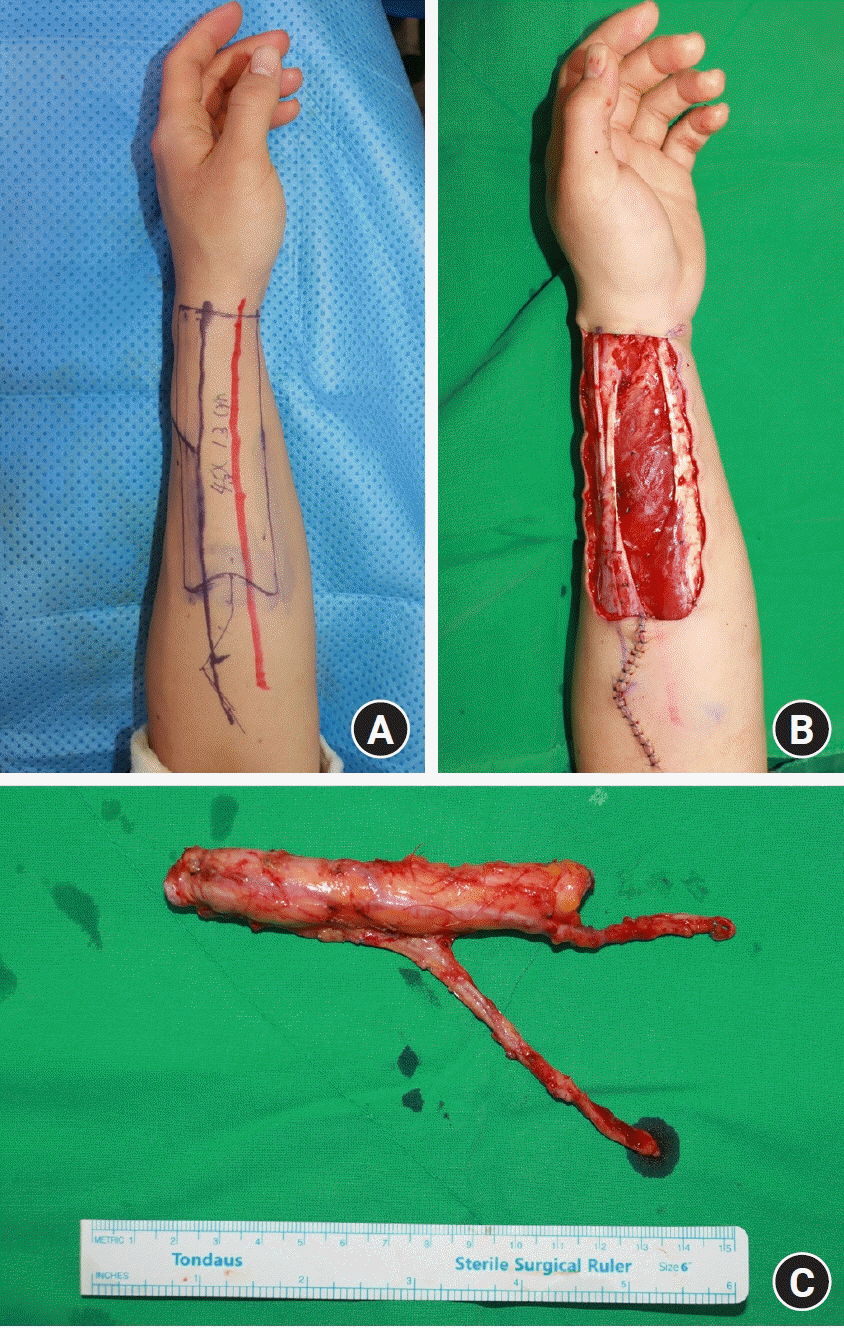
Fig. 2.
Postoperative photographs at 2 months. (A) The halted growth of the nail plate in multiple fingers can be observed (arrows). Note the growth of the rest of the fingernails in the same hand. (B) A close-up view of the affected fingernails, which show minor periungual redness and swelling. (C) Well-taken skin grafting and stable donor site.
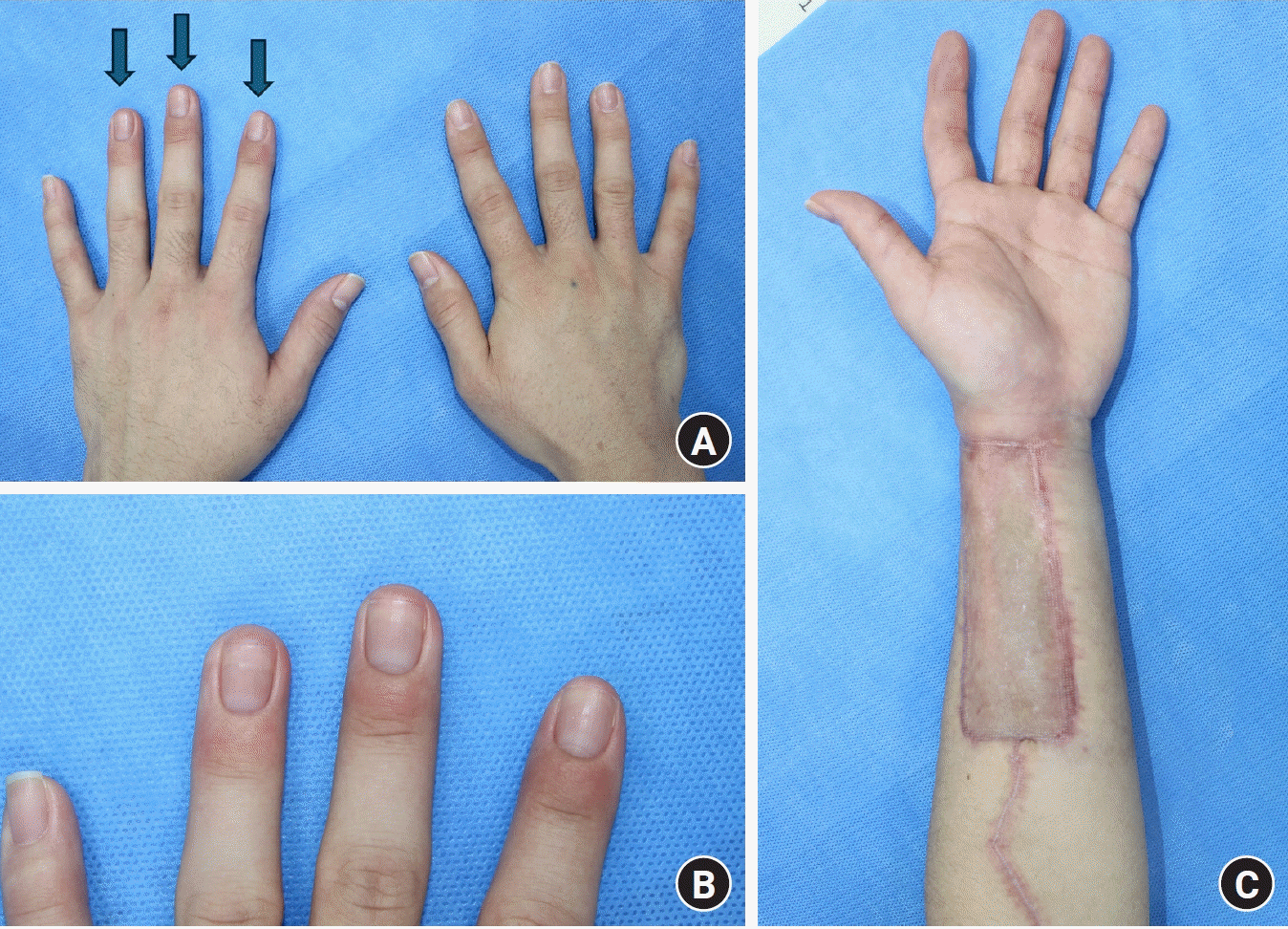
Fig. 3.
A postoperative photograph at 5 months. Periungual swelling has subsided. The nail plates have grown back in the affected fingers.
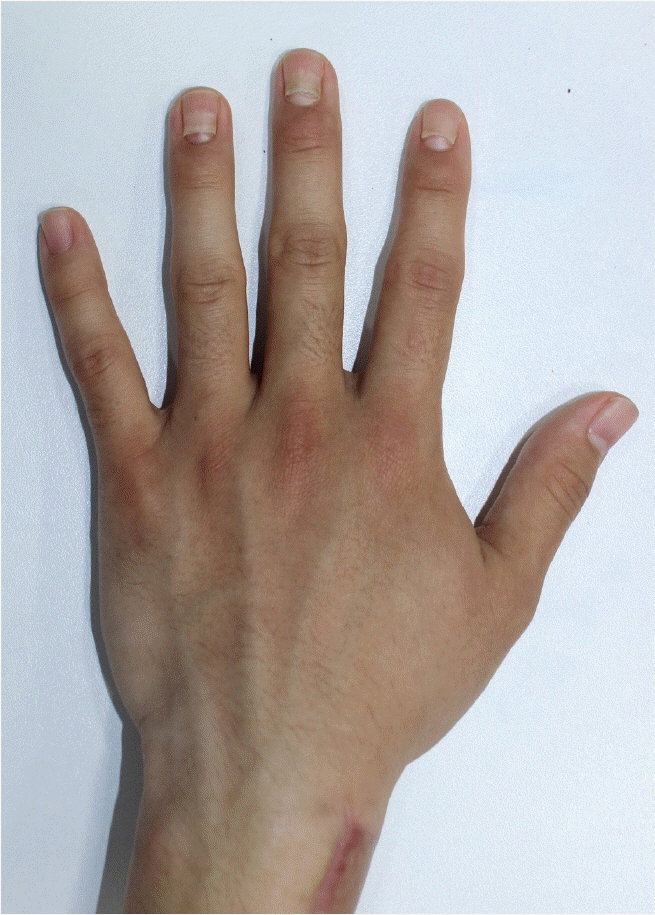




 PDF
PDF Citation
Citation Print
Print



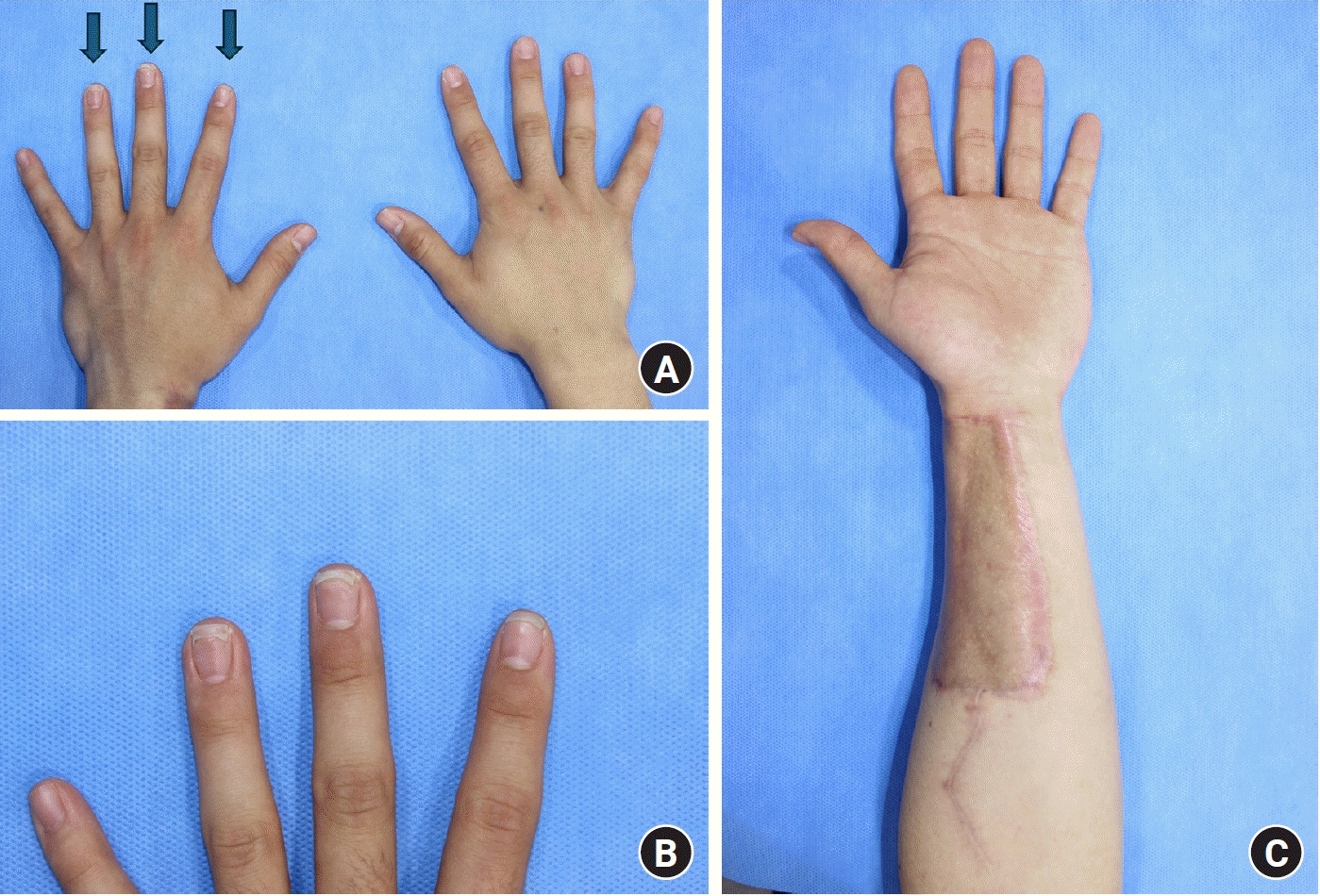
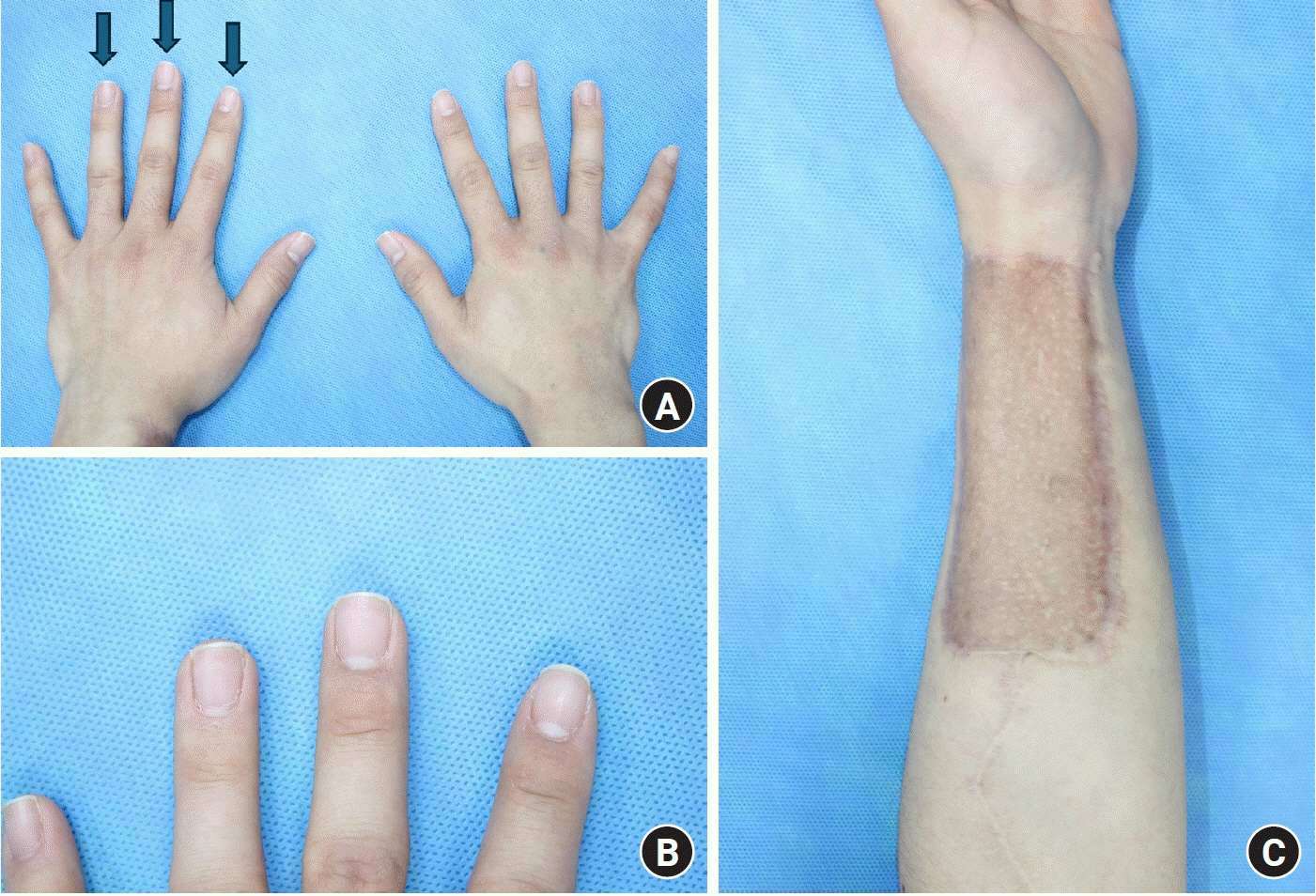
 XML Download
XML Download